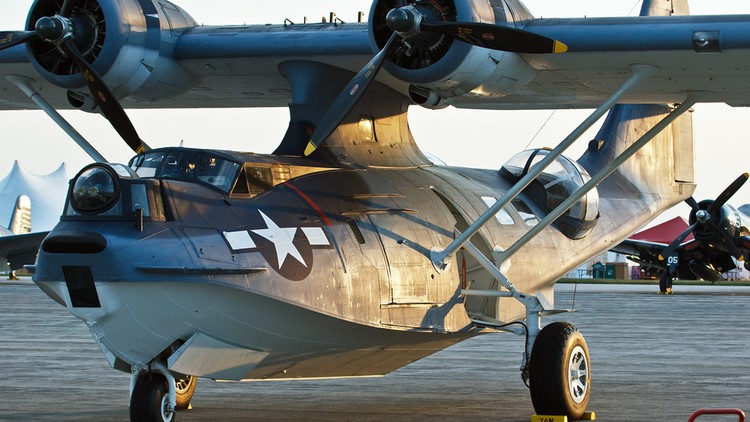
Graham “the Baron” Hesketh flying in VR is almost as good as the real thing but for FREE. (Which makes it BETTER)
What you will learn
Not just flying but the concept of flying an amphibian aircraft.
You should be able to master this aircraft very quickly having already done the basic C-172 or Pa28 course.
Sea planes can land on water but are vulnerable to waves and floating objects.
This classic historic aircraft was used as a long range patrol aircraft over water
Description
About 40 to 50 Catalinas are still flying today, although none for military operators: Most of them were converted to firefighting aircraft.
The Consolidated PBY CatalinaIs a free download on X-Plane 11 it is a flying boat and amphibious aircraft that was produced in the 1930s and 1940s. In Canadian service it was known as the Canso. It was one of the most widely used seaplanes of World War II. Catalinas served with every branch of the United States Armed Forces and in the air forces and navies of many other nations. The last military PBYs served until the 1980s. As of 2021, 86 years after its first flight, the aircraft continues to fly as a waterbomber (or airtanker) in aerial firefighting operations in some parts of the world. None remain in military service.
As American dominance in the Pacific Ocean began to face competition from Japan in the 1930s, the U.S. Navy contracted Consolidated, Martin and Douglas in October 1933 to build competing prototypes for a patrol flying boat. Naval doctrine of the 1930s and 1940s used flying boats in a wide variety of roles that today are handled by multiple special-purpose aircraft. The U.S. Navy had adopted the Consolidated P2Y and Martin P3M models for this role in 1931, but both aircraft were underpowered and hampered by inadequate range and limited payloads.
Consolidated and Douglas both delivered single prototypes of their new designs, the XP3Y-1 and XP3D-1, respectively. Consolidated’s XP3Y-1 was an evolution of the XPY-1 design that had originally competed unsuccessfully for the P3M contract two years earlier and of the XP2Y design that the Navy had authorized for a limited production run. Although the Douglas aircraft was a good design, the Navy opted for Consolidated’s because the projected cost was only $90,000 per aircraft.
PBY waist gunner mounting port side gun blister
Consolidated’s XP3Y-1 design (company Model 28) had a parasol wing with external bracing struts, mounted on a pylon over the fuselage. Wingtip stabilizing floats were retractable in flight to form streamlined wingtips and had been licensed from the Saunders-Roe company. The two-step hull design was similar to that of the P2Y, but the Model 28 had a cantilever cruciform tail unit instead of a strut-braced twin tail. Cleaner aerodynamics gave the Model 28 better performance than earlier designs. Construction is all-metal, stressed-skin, of aluminum sheet, except the ailerons and wing trailing edge, which are fabric covered.
The prototype was powered by two 825 hp (615 kW) Pratt & Whitney R-1830-54 Twin Wasp radial engines mounted on the wing’s leading edge. Armament comprised four .30 in (7.6 mm) Browning AN/M2 machine guns and up to 2,000 lb (910 kg) of bombs.
The XP3Y-1 had its maiden flight on 21 March 1935,[5] after which it was transferred to the U.S. Navy for service trials. The XP3Y-1 was a significant performance improvement over previous patrol flying boats. The Navy requested further development in order to bring the aircraft into the category of patrol bomber, and in October 1935, the prototype was returned to Consolidated for further work, including installation of 900 hp (670 kW) R-1830-64 engines. For the redesignated XPBY-1, Consolidated introduced redesigned vertical tail surfaces which resolved a problem with the tail becoming submerged on takeoff, which had made lift-off impossible under some conditions. The XPBY-1 had its maiden flight on 19 May 1936, during which a record non-stop distance flight of 3,443 mi (2,992 nmi; 5,541 km) was achieved.
The XPBY-1 was delivered to VP-11F in October 1936. The second squadron to be equipped was VP-12, which received the first of its aircraft in early 1937. The second production order was placed on 25 July 1936. Over the next three years, the design was gradually developed further and successive models introduced.
The aircraft eventually bore the name Catalina after Santa Catalina Island, California; the name was coined in November 1941, as Great Britain ordered their first 30 aircraft.
Content
Introduction